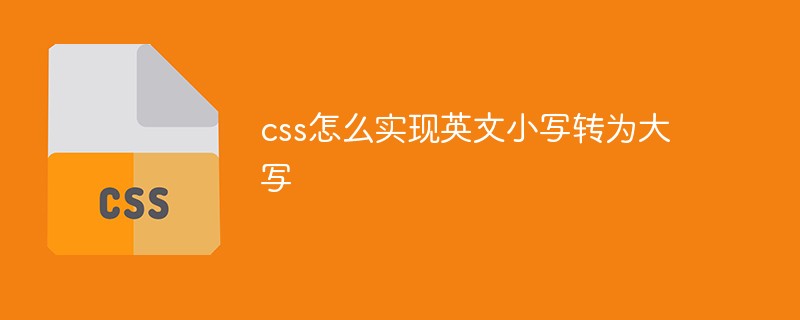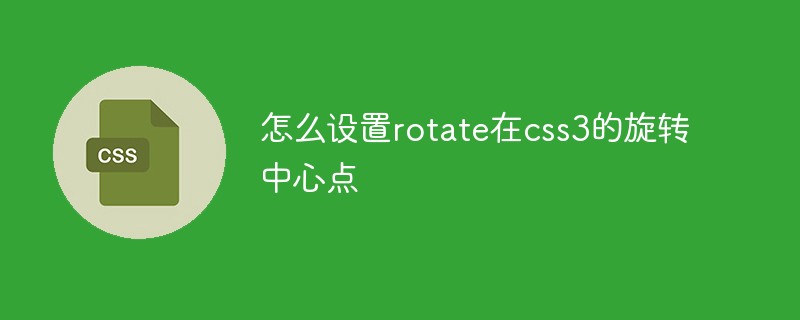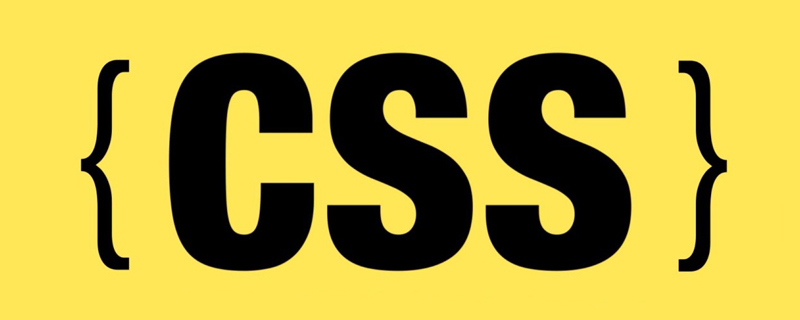The form of 2D transformation in CSS is like this:
选择器{
transform:转换函数(参数,参数);
}where transform ( is transform, not transfrom) is defined 2D or 3D conversion of elements;
2D conversion functions are divided into five categories:
translate() defines the displacement function; the following parameters are relative The offset distance of the x-axis and y-axis, in pixels, in the form: translate(30px,30px); indicates an offset of 30 pixels relative to the x-axis and the y-axis. It can be a negative value, indicating a reverse offset;
-
rotate() Define the function of rotation; define the element to rotate clockwise by a given angle, negative values are allowed, the element will rotate counterclockwise, the unit is angle deg (degree ), in the form rotate (30deg); the element is rotated 30 degrees clockwise, and a negative value indicates counterclockwise selection;
-
scale() defines the scaling function, according to Given the width (X axis) and height (Y axis) parameters, the element will be scaled, and the unit is a multiple, in the form of scale (2, 2); indicating that the element will be enlarged by 2 times on the x axis and y axis according to the original size. ; Can be a negative number, indicating rotation;
-
skew() defines the flip function, flipping based on the given (X-axis, Y-axis) parameters, unit is the angle deg, in the form of skew(30px,30px); it means that the element will be deflected by 30 degrees in the x-axis and y-axis direction; it can be a negative number, indicating reverse deflection;
- The
matrix() function method combines all 2D transformation methods to move, rotate, scale, and flip elements. Note: there is no defined perspective (perspective effect) and no expected deflection effect.
Example:
<!DOCTYPE html><html>
<head>
<meta charset="UTF-8">
<title>演示2D转换</title>
<style type="text/css">
#fr{
width: 500px;
height: 400px;
border: 1px solid green;
margin: 20px auto;
overflow: hidden;
}
.ch{
width: 80px;
height: 80px;
border: 1px solid black;
margin: 10px;
}
#fr p:first-child{
transform: translate(100px,0px);
-moz-transform: translate(100px,0px);
-webkit-transform: translate(100px,0px);
-o-transform: translate(100px,0px);
-ms-transform: translate(100px,0px);
}
#fr p:nth-child(2){
background-color: gray;
transform: rotate(30deg);
-webkit-transform: rotate(30deg);
}
#fr p:nth-child(3){
background-color: greenyellow;
transform: scale(1.5,1.5) translate(100px) }
#fr p:last-child{
transform: skew(30deg,20deg);
background-color: springgreen;
}
</style>
</head>
<body>
<p id="fr">
<p class="ch"></p>
<p class="ch"></p>
<p class="ch"></p>
<p class="ch"></p>
</p>
</p>
</body></html>Browser parsing page:

The first rectangle p is moved 100px relative to the original position (X axis);
The second rectangle p is rotated 30 degrees relative to its center;
The third rectangle p, moved 100px relative to its original position, and enlarged 1.5 times along the x-axis and y-axis directions;
The fourth rectangle p, flipped 30 degrees in the x-axis and y-axis directions respectively , 20 degrees;
The displacement, rotation, and flip of the functions here, each function has its own default relative position, which is also in line with our perceptual cognition. To modify the base point position of the rotation element, you can use the transform-origin function to define it;
Form: transform-origin:20% 40% (note that there are no brackets or "," Split); indicates that the relative deflection position moves 20% and 40% along the x-axis and y-axis according to the previous position movement. The w3c page demonstrates it very well
The default position is rotated according to the center of the element, which is the default position transform-origin: 50% 50%;If you want to rotate around the upper left corner of the element, use the parameters transform-origin: 0% 0%, the lower right corner transform-origin: 100% 100%, and so on. You can also use transform-origin:top left; transform-origin: bottom right; to define.
A browser compatibility issue: New versions of browsers seem to support 2D transformation defined by transform. In order to prevent compatibility issues with older versions of browsers (Chrome and Safari require the prefix -webkit-) , you need to do browser compatibility processing, because you never know how old the browser used by website visitors is!
ie browser: -ms-transform:
chrome and Safari browser: -webkit-transform:
Opera browser: -o-transform:
Firefox browser: -moz-transform:
The above is the detailed content of Summary sharing about 2D conversion in css. For more information, please follow other related articles on the PHP Chinese website!
 css ul标签怎么去掉圆点Apr 25, 2022 pm 05:55 PM
css ul标签怎么去掉圆点Apr 25, 2022 pm 05:55 PM在css中,可用list-style-type属性来去掉ul的圆点标记,语法为“ul{list-style-type:none}”;list-style-type属性可设置列表项标记的类型,当值为“none”可不定义标记,也可去除已有标记。
 css与xml的区别是什么Apr 24, 2022 am 11:21 AM
css与xml的区别是什么Apr 24, 2022 am 11:21 AM区别是:css是层叠样式表单,是将样式信息与网页内容分离的一种标记语言,主要用来设计网页的样式,还可以对网页各元素进行格式化;xml是可扩展标记语言,是一种数据存储语言,用于使用简单的标记描述数据,将文档分成许多部件并对这些部件加以标识。
 css3怎么实现鼠标隐藏效果Apr 27, 2022 pm 05:20 PM
css3怎么实现鼠标隐藏效果Apr 27, 2022 pm 05:20 PM在css中,可以利用cursor属性实现鼠标隐藏效果,该属性用于定义鼠标指针放在一个元素边界范围内时所用的光标形状,当属性值设置为none时,就可以实现鼠标隐藏效果,语法为“元素{cursor:none}”。
 rtl在css是什么意思Apr 24, 2022 am 11:07 AM
rtl在css是什么意思Apr 24, 2022 am 11:07 AM在css中,rtl是“right-to-left”的缩写,是从右往左的意思,指的是内联内容从右往左依次排布,是direction属性的一个属性值;该属性规定了文本的方向和书写方向,语法为“元素{direction:rtl}”。
 css怎么实现英文小写转为大写Apr 25, 2022 pm 06:35 PM
css怎么实现英文小写转为大写Apr 25, 2022 pm 06:35 PM转换方法:1、给英文元素添加“text-transform: uppercase;”样式,可将所有的英文字母都变成大写;2、给英文元素添加“text-transform:capitalize;”样式,可将英文文本中每个单词的首字母变为大写。
 css怎么设置i不是斜体Apr 20, 2022 am 10:36 AM
css怎么设置i不是斜体Apr 20, 2022 am 10:36 AM在css中,可以利用“font-style”属性设置i元素不是斜体样式,该属性用于指定文本的字体样式,当属性值设置为“normal”时,会显示元素的标准字体样式,语法为“i元素{font-style:normal}”。
 怎么设置rotate在css3的旋转中心点Apr 24, 2022 am 10:50 AM
怎么设置rotate在css3的旋转中心点Apr 24, 2022 am 10:50 AM在css3中,可以用“transform-origin”属性设置rotate的旋转中心点,该属性可更改转换元素的位置,第一个参数设置x轴的旋转位置,第二个参数设置y轴旋转位置,语法为“transform-origin:x轴位置 y轴位置”。


Hot AI Tools

Undresser.AI Undress
AI-powered app for creating realistic nude photos

AI Clothes Remover
Online AI tool for removing clothes from photos.

Undress AI Tool
Undress images for free

Clothoff.io
AI clothes remover

AI Hentai Generator
Generate AI Hentai for free.

Hot Article

Hot Tools

Atom editor mac version download
The most popular open source editor

Dreamweaver CS6
Visual web development tools

Safe Exam Browser
Safe Exam Browser is a secure browser environment for taking online exams securely. This software turns any computer into a secure workstation. It controls access to any utility and prevents students from using unauthorized resources.

MantisBT
Mantis is an easy-to-deploy web-based defect tracking tool designed to aid in product defect tracking. It requires PHP, MySQL and a web server. Check out our demo and hosting services.

Zend Studio 13.0.1
Powerful PHP integrated development environment







